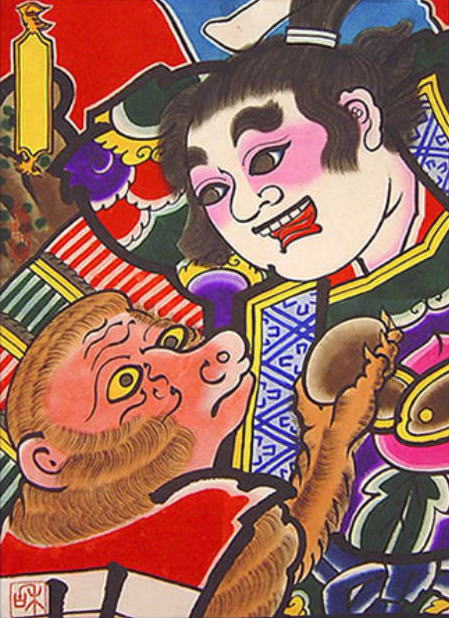・金太郎と猿
¥12,000
サイズ 西の内2枚版
■商品コード T-16012■
▶注文(メール)
¥12,000
Size: Nishi-Nouchi 2-page
edition
Product code T-16012
▶email order
- 価格は、「本体価格」表記です。別途、消費税が加算されます。
- これらの津軽凧絵は、絵のみとなります。
(骨組みを有する凧ではありません。)
注文制作となりますので、繁忙期の有無によりますが、数か月かかる場合がございますので、お尋ねください。 - 額入の場合、額の種類等により価格が異なりますので、ご相談ください。
- サイズは、西の内の尺度となります。
西の内1枚(333mm×485mm)は、半紙(243mm×333mm)2枚。
- All prices are listed in the table below. A separate consumption tax will be added.
- These Tsugaru kite paintings are paintings only.
(It's not a kite with a frame.) - It may take several months depending on the busy season, so please contact us.
- The price of a framed picture differs depending on the type of the frame, so please consult with us.
- The size will be on a scale of Nishinouti (west inside).
One sheet (333mm x 485mm) of Nishinouti (west inside) is two sheets of half-paper (243mm x 333mm).

- 金太郎にはいくつも伝説が存在する。 静岡県駿東郡小山町の金時神社(金太郎が祭られている神社)に記されたものによると、天暦10年(956年)5月に誕生したという。
- 彫物師十兵衛の娘、八重桐(やえぎり)が京にのぼった時、宮中に仕えていた坂田蔵人(くらんど)と結ばれ懐妊した子供とされる。八重桐は故郷に帰り金太郎を産んだが、坂田が亡くなってしまったため、京へ帰らず故郷で育てることにした。
- 成長した金太郎は足柄山で熊と相撲をとり、母に孝行する元気で優しい子供に育った。そして天延4年3月21日(976年4月28日)、足柄峠にさしかかった源頼光と出会い、その力量を認められて家来となる。名前も坂田金時(きんとき)と改名し、京にのぼって頼光四天王の一人となる。
- なお、他には渡辺綱、卜部季武、碓井貞光が四天王に名を連ねる。
- 永祚2年3月26日(990年4月28日)、丹波の国、大江山(現在京都府福知山市)に住む酒呑童子を退治する。酒呑童子は都に訪れては悪いことをするため、源頼光や四天王たちが山伏姿に身をかえ、神変奇特酒(眠り薬入り酒)を使って退治した。
- 坂田金時は寛弘8年12月15日(1012年1月11日)、九州の賊を征伐するため築紫(つくし・現在北九州市)へ向かう途中、作州路美作(みまさか)勝田壮(現在の岡山県勝央町)にて重い熱病にかかり死去。
- 享年55だったという。勝田の人々は公時を慕い、倶利加羅(くりがら、剛勇の意)神社を建てて葬った。その神社は現在、栗柄神社と称する。以上が金時神社に記された金太郎の伝説である。
- There are a number of legends about Kintaro.
Kintaro was born in May of the 10th year of Tenryaku (956), according to an entry in the Kintoki Shrine (the shrine where Kintaro is enshrined) in Oyama-cho, Sunto-gun, Shizuoka Prefecture. - It is said that Yae Kiri, the daughter of the sculptor Jubei, married Sakata Kurando, who served at the court, and carried the child to term when she came to Kyoto.
Yaegiri returned to her hometown and gave birth to Kintaro, but when Sakata died, she decided not to return to Kyoto but to raise him in her hometown. - When Kintaro grew up, he wrestled with bears on Mount Ashigara and grew up to be an energetic and kind child who was devoted to his mother.
On March 21 of the 4th year of Tenobu (April 28, 976), he met Minamoto Yorimitsu on the way to Ashigara Pass, and was recognized for his strength and became a retainer.
He also changed his name to Kintoki Sakata, and became one of the Four Heavenly Kings of Yorimitsu ascending to Kyoto. - Tsuna Watanabe, Toshitake Urabe, and Sadamitsu Usui are the other names in the list of "Four Heavenly Kings".
- On March 26 (April 28, 990) of the 2nd year of the accession to the throne, he overthrew a boy who lived in Oeyama (now Fukuchiyama City, Kyoto Prefecture) in Tanba Province.
Because the drinking doji would do bad things when they visited the city, Minamoto Yorimitsu and the Four Heavenly Kings disguised themselves as mountain priests and exterminated them with Shinbunki-chiitoku sake (sake containing sleeping pills). - Sakata Kintoki died of a serious fever on December 15, 1012 (January 11, 1012), on his way to Tsukiji (Tsukushi, now Kitakyushu City) to conquer bandits in Kyushu, at Katsuta-so in Mimasaka, Sakushu Road (now Katsura-machi, Okayama Prefecture).
- Sakata Kintoki died of a serious fever on December 15, 1012 (January 11, 1012), on his way to Tsukiji (Tsukushi, now Kitakyushu City) to conquer bandits in Kyushu, at Katsuta-so in Mimasaka, Sakushu Road (now Katsura-machi, Okayama Prefecture).